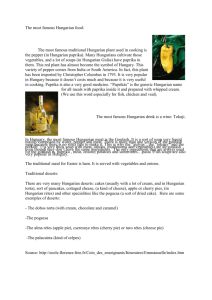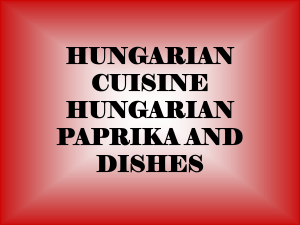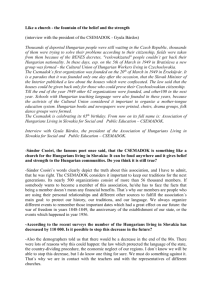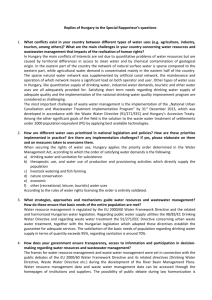Hungary Location
advertisement
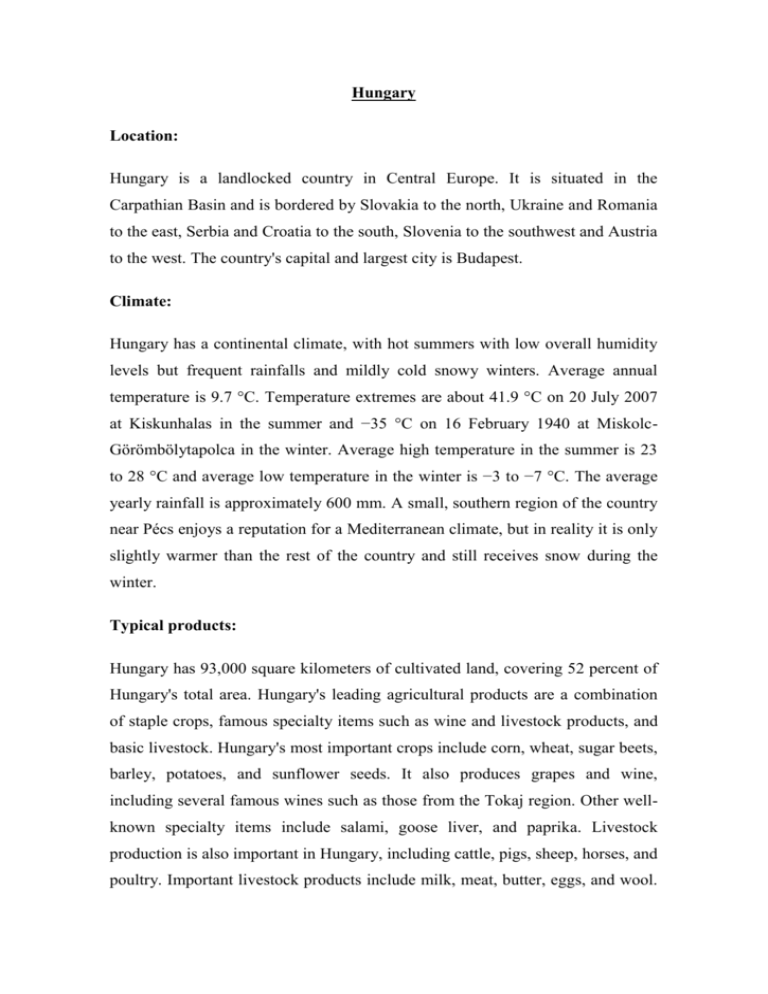
Hungary Location: Hungary is a landlocked country in Central Europe. It is situated in the Carpathian Basin and is bordered by Slovakia to the north, Ukraine and Romania to the east, Serbia and Croatia to the south, Slovenia to the southwest and Austria to the west. The country's capital and largest city is Budapest. Climate: Hungary has a continental climate, with hot summers with low overall humidity levels but frequent rainfalls and mildly cold snowy winters. Average annual temperature is 9.7 °C. Temperature extremes are about 41.9 °C on 20 July 2007 at Kiskunhalas in the summer and −35 °C on 16 February 1940 at MiskolcGörömbölytapolca in the winter. Average high temperature in the summer is 23 to 28 °C and average low temperature in the winter is −3 to −7 °C. The average yearly rainfall is approximately 600 mm. A small, southern region of the country near Pécs enjoys a reputation for a Mediterranean climate, but in reality it is only slightly warmer than the rest of the country and still receives snow during the winter. Typical products: Hungary has 93,000 square kilometers of cultivated land, covering 52 percent of Hungary's total area. Hungary's leading agricultural products are a combination of staple crops, famous specialty items such as wine and livestock products, and basic livestock. Hungary's most important crops include corn, wheat, sugar beets, barley, potatoes, and sunflower seeds. It also produces grapes and wine, including several famous wines such as those from the Tokaj region. Other wellknown specialty items include salami, goose liver, and paprika. Livestock production is also important in Hungary, including cattle, pigs, sheep, horses, and poultry. Important livestock products include milk, meat, butter, eggs, and wool. Finally, Hungary has some important freshwater fisheries, mostly located on the Danube and Tisza rivers, and on Lake Balaton. The commercial fish catch consists mainly of carp, pike, perch, sheatfish, and shad. Eating times: Hungarian cuisine is a prominent feature of the Hungarian culture, just like the art of hospitality. Traditional dishes such as the world famous Goulash (gulyás stew or gulyás soup) feature prominently. Dishes are often flavoured with paprika (ground red peppers), a Hungarian innovation. The paprika powder, obtained from a special type of pepper, is one of the most common spices used in typical Hungarian cuisine. The best quality of paprika comes from the city of Kalocsa. Thick, heavy Hungarian sour cream called tejföl is often used to soften the dishes' flavour. The famous Hungarian hot river fish soup called Fisherman's soup or halászlé is usually a rich mixture of several kinds of poached fish. Other dishes are chicken paprikash, foie gras made of goose liver, pörkölt stew, vadas, (game stew with vegetable gravy and dumplings), trout with almonds and salty and sweet dumplings, like túrós csusza, (dumplings with fresh quark cheese and thick sour cream). Desserts include the iconic Dobos Cake, strudels (rétes), filled with apple, cherry, poppy seed or cheese, Gundel pancake, plum dumplings (szilvás gombóc), somlói dumplings, dessert soups like chilled sour cherry soup and sweet chestnut puree, gesztenyepüré (cooked chestnuts mashed with sugar and rum and split into crumbs, topped with whipped cream). Perec and kifli are widely popular pastries. Pálinka: is a fruit brandy, distilled from fruit grown in the orchards situated on the Great Hungarian Plain. It is a spirit native to Hungary and comes in a variety of flavours including apricot (barack) and cherry (cseresznye). However, plum (szilva) is the most popular flavour. Beer: Beer goes well with many traditional Hungarian dishes. The five main Hungarian brands are: Borsodi, Soproni, Arany Ászok, Kõbányai, and Dreher. Wine: As Hugh Johnson says in The History of Wine, the territory of Hungary is ideal for wine-making. Since the fall of communism there has been a renaissance in Hungarian wine-making. The choice of quality wine is widening from year to year. The country can be divided to six wine regions: North-Transdanubia, Lake Balaton, South-Pannónia, Duna-region or Alföld, Upper-Hungary and TokajHegyalja. For over 150 years, a blend of 40 Hungarian herbs has been used to create the liqueur Unicum. Unicum is a bitter, dark-coloured liqueur that can be drunk as an apéritif or after a meal, thus helping the digestion. The typical mealtime of Hungarian people is very similar to the British mealtime. They usually have breakfast when they wake up to go to work or school. They usually have lunch during workday so they usually have lunch at 12 o’clock or 1 p.m. o’clock. They usually have dinner when they finish their workday and it happens at 6 o’clock in the evening. They have dinner earlier than us because the day in Hungary is shorter than here. Famous dishes and recipes: GOULASH SOUP Ingredients: 400 g beef shank or chuck 20 mm cubed 1-2 onion 1 spoonful oil salt 1 spoonful paprika powder 1 clove of garlic 1 teaspoon of caraway seed and black pepper 1-3 bay leaf 1-2 carrot diced 1 Hungarian green pepper (zöldpaprika) 2 tomatoes celery leaf parsley 1 parsnip 2 potatoes cubed Steps: 1. Cut the onion into small pieces and brown it in hot oil. Add the chopped meat, stir until well browned and powder it with paprika powder and stir well. 2. Add fast a little water and stir well. Add salt, the clove of garlic, the caraway seeds, black pepper, bay leaf and tomatoes, a little water and let simmer for about 30 minutes. 3. Add enough water to cover the meat well. Add carrot, parsnip, green pepper, celery leaf, parsley and bring to a boil. Turn to low heat and simmer for 10 minutes. 4. Add potatoes and more water to soup consistency. Salt to taste. Simmer until potatoes and meat are well cooked. HUNGARIAN POPPY SEED ROLLS, CALLED BEIGLI Ingredients: 8g of traditional active dry yeast ( 1 package) 60-120 ml of milk 4g of granulated sugar 1⁄4 cup of lukewarm milk 500gr. of all-purpose flour 1/3 cup + 1 tbsp. ( 94 ml) icing sugar 1⁄4 tbsp. ( 1.5 gr.) salt 1 1⁄2 sticks (170gr.) of unsalted butter 3 egg yolks Poppy Seeds filling: 2/3 cups poppy seeds grind well 5 tbsp. sugar 1/2 tbsp. honey 1/4 tsp + 1/2 tsp grated lemon rind 1/2 tbsp. +1/4 tbsp. +1/4 tbsp. apricot jam Steps: 1. Dissolve the yeast and granulated sugar in 1/4 cup of lukewarm milk. Set aside for 10 minutes until the liquid forms a foamy mixture. 2. Combine the flour, icing sugar, and salt in a large bowl. Cut in the butter. Mix well. 3. Make a well in the centre and add the yeast mixture and egg yolks. Mix gently, gradually adding 1⁄4 to 1⁄2 cup milk until the dough can be formed into a ball. Cover with a cloth and let rise until double in size (2 hours). 4. Grind the poppy seeds separately. Mix the ingredients for the fillings separately in a medium saucepan and simmer over a low heat for 15 minutes, stirring frequently. 5. Remove from the stove and allow to cool. 6. Divide the dough into two halves and roll each half on a floured surface into 12x18 inch rectangles. Spread the fillings on the rectangle leaving a margin of a least an inch on all edges. 7.Turn up the sides to prevent leaking and roll it lengthwise to form two 12-inch rolls. Brush the tops of the rolls with egg whites; poke a few holes in them with a fork. PORKOLT (Hungarian Stew) Made With Pork Ingredients: 5 slices bacon 2 large onions 1/4 cup Hungarian paprika 1 and 1/2 teaspoons garlic powder 1/4 teaspoon ground black pepper 5 pounds boneless pork chops 1 large yellow bell pepper 2 cans diced tomatoes, with liquid 2/3 cup beef broth 2 cups reduced-fat sour cream 2 packages wide egg noodles Steps: 1. Place the bacon in a large, deep skillet, and cook over medium-high heat until evenly browned, about 10 minutes. Drain, and reserve the drippings. 2. Add the onions to the bacon and cook together until the onion is translucent. Remove skillet from heat and stir the paprika, garlic powder, and pepper into the bacon mixture. 3. Transfer the mixture into a large stockpot. Cut into bite-sized cubes and stir into the bacon mixture. 4. Heat a small amount of the bacon drippings in the skillet; cook and stir the bell pepper in the hot drippings until softened and fragrant; drain on a plate lined with paper towels. Stir the cooked pepper into the bacon mixture. 5. Pour the tomatoes with liquid and beef broth into a stockpot and place the pot over medium-high heat. Bring to a simmer and reduce heat to medium-low. 6. Cook until the stew begins to thicken, stirring occasionally, about 90 minutes. Stir the sour cream into the stew just before serving. 7. Bring a pot with lightly-salted water and bring to a rolling boil; add the egg noodles to the water and return to a boil. Cook uncovered, stirring occasionally, until the pasta has cooked through, but is still firm to the bite, about 5 minutes. Drain well in a colander set in the sink. 8. Ladle the stew over the drained noodles to serve.
